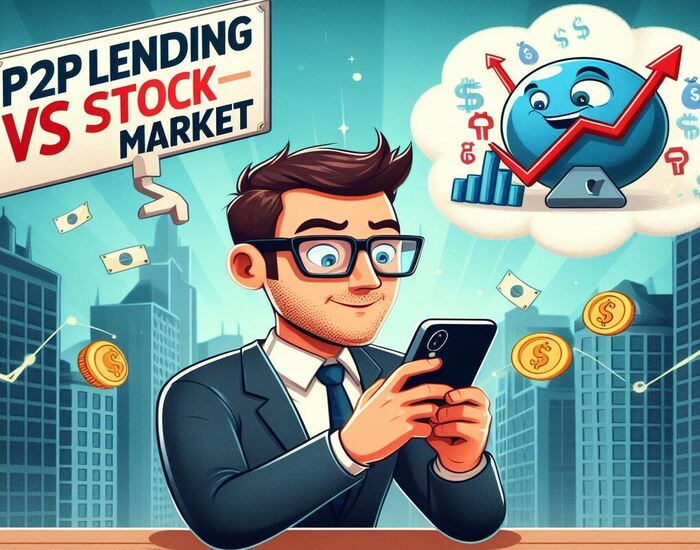The debate surrounding “P2P lending vs stock market and which is better investment?” echoes the sentiments of those navigating the intricate web of investment choices. P2P lending, with its peer-to-peer lending platforms, and the stock market, a stalwart of investment, each present unique opportunities and risks. In this exploration, we dissect the dynamics of both realms, aiming to unravel the intricacies that influence the decision-making process for investors seeking the optimal path to financial growth. Join us as we delve into the realms of peer-to-peer lending and the stock market to decipher which avenue holds the promise of being a superior investment.
Understanding P2P Lending
P2P lending functions primarily on a basic basis that borrowers can create profiles on these sites detailing their credit histories, repayment capacities, and borrowing needs. Conversely, investors that are eager to add diversity to their portfolios and seek possible rewards can check out these borrower profiles. Before approving a loan, they consider several variables, including risk tolerance, loan purpose, and creditworthiness.
The platform handles all administrative tasks, such as loan disbursement, documentation, and installment collections, after a lender chooses which borrower to invest in. By minimizing operational complexity, the platform’s flawless management of procedures guarantees a hassle-free experience for both lenders and borrowers.
The effectiveness of P2P financing in eliminating middlemen is one of its main benefits. P2P lending platforms lower overhead expenses and streamline the lending process by doing away from traditional financial middlemen like banks and credit unions. This makes it a desirable option for all parties since it frequently results in reduced interest rates for borrowers and maybe larger profits for lenders.
Additionally, peer-to-peer lending encourages a spirit of community-driven financial cooperation by enabling people to actively assist one another in their financial pursuits. It democratizes credit availability, particularly for marginalized or underprivileged populations that might find it difficult to get loans through conventional channels because of strict qualifying requirements.
Advantages of P2P Lending Investments
- Diversification: Since a wide range of borrowers are available on peer-to-peer (P2P) lending platforms, investors can distribute their money among different interest rate ranges. They diversify their investments this way, reducing the possible impact of a single loan default on their portfolio. It’s similar to not putting all of your eggs in one basket.
- Transparency: There is a great degree of transparency in P2P lending. This implies that relevant data on borrowers, lending conditions, and payback plans are available to prospective investors right away. Because of this transparency, investors are better able to weigh the benefits and dangers of their options and make well-informed decisions.
- Consistent profits: P2P lending has the potential to give investors consistent, dependable profits. Returns on P2P lending is rather stable, in contrast to typical investment routes where market volatility can cause considerable fluctuations. Because they may select the level of risk they want to take on, investors can customize their investment plan to fit their risk tolerance and financial objectives.
Returns and Risk of P2P Lending Investments
Exploring the world of P2P lending involves understanding the risks and returns – it’s like finding a balance between earning rewards and being cautious about potential challenges.
- Returns: P2P loans usually have favorable returns, averaging between 11 and 13% annually. P2P lending is a desirable choice for investors looking for greater rates because these returns are larger than those of traditional fixed deposits or savings accounts.
- Risk: P2P lending carries some risk even if it has the potential to yield larger profits. Borrower defaults remain a possibility even though the danger of losing capital is comparatively smaller than with some other investment options, such equities. This risk emphasizes how crucial it is to do extensive research and diversify your investments when making P2P loans to reduce potential losses.
All about Stock Market Investments
Investors can purchase and sell shares of publicly traded firms on the stock market, and stockbrokers and portfolio managers are among the intermediaries who help with investment management. Equity in companies listed on stock exchanges such as SEBI Stock Exchange Bureau of India is bought by investors. However, there is inherent volatility associated with stock market investing, meaning that stock prices might change dramatically over time.
External variables including the state of the economy, news about companies, and market sentiment all impact this volatility. The state of the market is reflected in market sentiment, whereas inflation, interest rates, and unemployment rates are examples of economic conditions. Furthermore, news about the company, such as earnings releases or new product introductions, might affect stock values. Because of this volatility, stock market investment entails a certain amount of risk, so investors must exercise caution and make well-informed decisions.
Transparency and complexity:
- Transparency: The stock market is less transparent than peer-to-peer lending. Investors rely on market research, company reporting, and professional judgement.
- Complexity: Investing in the stock market involves knowledge and comprehension. Investors need to examine macroeconomic variables, industry trends, and financial statements.
Risks and Returns of Stock Market Investments:
- Returns: Stocks can provide larger returns, often surpassing 20% yearly. These benefits do, however, come with a higher risk.
- Risk: Market downturns can result in large losses, and stock values can be erratic. Investors must be ready for market volatility.
Conclusion:
In conclusion, the debate around P2P lending vs stock market and which investment to choose depends on an individual’s risk tolerance and investing objectives. P2P lending appeals to cautious investors looking for stability because it provides consistent profits at a lower risk. However, the stock market demands a tolerance for market fluctuations in exchange for its larger promised returns. To balance risk and profit, some investors choose a diversified strategy that combines stock investments with peer-to-peer lending. In the end, the choice should be in line with one’s long-term financial goals and risk tolerance.
When choosing between P2P lending and the stock market, keep in mind that personal preferences, risk tolerance, and financial objectives are all important considerations. Consider your options and make a well-informed decision!




